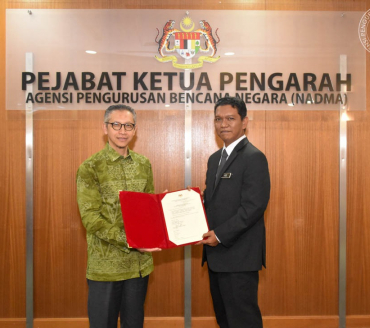A RECENTLY constructed flood retention pond at Taman Teluk Pulai, in Klang, Selangor is causing frustration among residents who say it has failed to serve its intended purpose.
The pond located at Lorong Serampang 1 has not providng much-needed flood mitigation, they say.
The residents said hoarding around the premises was removed at the end of March. They questioned the retention pond’s efficacy, describing it as a “sunken field”.
Despite the existence of a retention pond in the neighbourhood, a flood occurred two weeks ago leaving homes waterlogged after 20 minutes of rain.
Ampika Pathy, 80, said floods in the area, before MBDK turned the land into a retention pond, were not as severe.
“We noticed that the recent floods were worse because water overflowed onto the main road. “Traffic was chaotic and motorists driving down from Teluk Pulai overhead bridge had to make a U-turn,” he said.
Along Jalan Teluk Pulai, Star Metro noticed a signboard stating that the reservoir was to meet urban storm water management needs. It also said: “During heavy rains, this area will hold water before it is slowly released to prevent flooding in downstream areas.
“The water level will rise and fall slowly, so you are advised to leave this area when it rains heavily. “This area can be used for recreation during dry weather.”
Residents said when dry, the sunken field turned into a rubbish dump. S. Gunarasa, 80, said there were two outlets for water to flow into the monsoon drains but this was not happening and that his house in Lorong Sepat 3 got flooded.
He added that he had lodged multiple complaints with MBDK. “There are overgrown plants in the drains, which have not been cleaned in months.
“The soil and silt must be removed.” Lee Siew Guat, 70, who has been living next to the retention pond for three years, said she was shocked to see how the area was inundated with water.
“My neighbours who have been here for the last 40 years have also never seen such bad flooding.” Teluk Pulai Residents Association chairman Santokh Singh questioned the rationale and mechanism used by MBDK when the retention pond was planned.
“There was no feasibility study. The monsoon drains surrounding the neighbourhood have not been cleaned, which is also the cause for the flooding,” he said. R. Ramachandran, 75, who lives behind the Teluk Pulai KTM Komuter station, said he had to place a stone slab at the entrance of his house to keep floodwaters out.
“It has worsened in the last 10 years,” he said, adding that poor drainage around the station carpark contributed to the problem. MBDK did not reply to StarMetro’s request for feedback at press time.
With floods on the rise, one English city is turning to beavers’ wisdom and wooden barriers
- Admin UKK
- Berita
LEICESTER, May 12 — In a stream near Leicester in central England, six volunteers in waterproof overalls and boots busily reinforced mini wooden structures designed to combat the rising flooding threat.
The city, like many others in the UK, has experienced several intense rainfall events in recent years, which have caused significant damage.
Alert to climate change, which intensifies these events, authorities are strengthening their defences and turning to solutions more sympathetic with the environment.
With their feet firmly planted on the bed of the Saffron Brook, a tributary of the River Soar that runs through Leicester, the volunteers ensured the structures’ wooden bundles were securely anchored.
These structures create bends that “change the behaviour of the river” and slow down water in stretches where it currently flows “straight and very fast,” said Dan Scott, who leads the programme at the Trent Rivers Trust, a local group working to protect rivers.
He regularly oversees the installation of new facilities. A few months ago, the trust dug a pond on a river near the town of Loughborough and installed dozens of leaky wooden barriers to better protect downstream houses that flooded in the past.
These techniques are “complementary to traditional flood defences” such as retention basins and canals that are increasingly under strain, Scott said.
They “help to store some of that water upstream so that those traditional flood defences don’t get overwhelmed, and if they do, it’s not as quickly as if these features weren’t in place,” he added. They also help to maintain biodiversity.
‘Urgent problem’
More than 6.3 million properties are at risk of flooding in the UK, and this figure will rise to more than eight million by 2050, according to a recent government report.
“Flooding is a really urgent societal problem,” said Steven Forest, director of the Flood Risk Management Program at the University of Hull.
Climate events resulted in UK insurance payouts of more than £400 million (RM2.27 billion) in 2022 and more than £570 million in 2023 and 2024, half of which was related to flooding, according to the Association of British Insurers.
Beyond traditional defences, “we need to think about living with water, and we need to think about integrating water within our urban spaces,” Forest added.
He cited the Netherlands, which allocates space for rivers to drain during heavy rainfall, and the United States, where vegetation “buffer zones” were created after Hurricane Sandy in 2012.
“Straight-jacketing” waterways with various infrastructure is no longer sufficient, Forest said, especially since seven percent of such structures were assessed to be in “poor” or “very poor” condition by the UK Environment Agency in 2022.
Overcoming scepticism
But convincing residents and authorities is not always an easy task as it often needs explaining that “just because we’ve not built a concrete solution, that it isn’t going to be as effective,” Scott said.
“It’s also about re-educating people in government because it’s easier for them to sell something (to voters) that’s physical and much more prominent within the landscape,” he added.
Traditional developments attracted the lion’s share of the £2.6 billion announced by the government in March to fund new flood defence systems over the next two years.
But Scott noted a greater interest in natural flood management over the past five years, with the previous government launching a £25 million programme last year.
As a result, Leicester will be able to develop several waterways southeast of the city, and 35 other projects have been selected in England.
“It is encouraging that our successful approach to natural flood management measures is continuing to be supported,” Geoff Whittle, a local councillor responsible for the environment, told AFP.
Contemplating the fruits of her labour in Saffron, 50-year-old volunteer Lis Gibbs told AFP that “it feels like you can make a difference,” in contrast to climate change in general, which “can feel really overwhelming”. — AFP
Kuala Lumpur: Angkatan Pertahanan Awam Malaysia (APM) bersiap siaga melalui pemantauan secara rondaan di lokasi titik panas yang berisiko mengalami bencana di seluruh negara sepanjang tempoh Monsun Barat Daya bermula Sabtu lalu hingga September ini.
Jurucakap APM berkata, pihaknya juga menubuhkan pasukan pemantauan dikenali Op Ramah bagi memantau beberapa kawasan dikenalpasti atau lokasi titik panas yang berisiko berdepan bencana sejak 2023.
"Antara kawasan yang boleh mendatangkan risiko kecemasan atau bencana seperti kawasan tanah gambut, kawasan tapak pelupusan sampah, kebakaran lalang serta sebagainya.
"Justeru, APM sentiasa siaga dalam menghadapi situasi seperti itu dengan penugasan di talian kecemasan 999 selain rondaan Op Ramah secara harian untuk pemantauan aktiviti masyarakat yang boleh mengundang kepada kemalangan atau bencana," katanya, hari ini.
Menurutnya kenyataan itu lagi, APM sentiasa bekerjasama dengan jabatan dan agensi lain seperti Jabatan Alam Sekitar, pihak berkuasa tempatan (PBT), Jabatan Pengairan dan Saliran (JPS) dalam penugasan operasi itu.
"Bagi memastikan penugasan ini (lancar), APM juga mengadakan kerjasama dengan beberapa agensi melalui Nota Persefahaman (NOU)," katanya.
Orang ramai juga dinasihatkan supaya lebih peka dan berhati-hati sepanjang tempoh berkenaan yang sering dikaitkan dengan cuaca panas dan kering.
"APM melalui rondaan dilakukan sentiasa memberi nasihat kepada masyarakat berkaitan cuaca panas selain mengedarkan risalah berkaitan menghadapi cuaca panas termasuk ancaman binatang berbisa," katanya.
Terdahulu, media melaporkan Monsun Barat Daya dijangka bermula pada 10 Mei dan berterusan sehingga September ini susulan tiupan angin yang mula bertiup secara konsisten dari arah barat daya ke rantau negara.
Ketua Pengarah Jabatan Meteorologi Malaysia (METMalaysia) Dr Mohd Hisham Mohd Anip berkata sepanjang musim berkenaan, kadar kelembapan udara lazimnya rendah, sekali gus menyebabkan kurangnya pembentukan awan hujan di kebanyakan tempat.
Bagaimanapun, hujan lebat berserta angin kencang dan ribut petir masih boleh berlaku di kawasan barat Semenanjung, utara Sarawak dan barat Sabah, terutamanya pada awal pagi, berikutan kehadiran fenomena garis badai.
Ketika kemuncak monsun berkenaan iaitu antara Julai hingga September, fenomena jerebu setempat dan rentas sempadan boleh berlaku sekiranya aktiviti pembakaran terbuka tidak dikawal.
Sebarang pembakaran terbuka perlu dielakkan bagi mengurangkan risiko pencemaran jerebu, selain menggalakkan orang ramai menggunakan air secara berhemah sepanjang musim itu.
Using a carbon market-like tool to control air pollution can help developing countries such as India where the standard approach of limiting the emissions with policy making is falling short, a new study has found.
Air pollution is one of the most pressing health issues in India, where the country’s 1.4 billion people breathe air exceeding the World Health Organisation’s guidelines for particulate matter (PM).
Those are particles finer than human hair that can cause severe health issues such as respiratory infections and even lung cancer. This pollution costs the average Indian resident 3.5 years of life expectancy.
Industry is one of the major sources of air pollution in the country, and policymakers have struggled to deal with it by taking the standard approach of creating and enforcing laws around emission limits.
In fact, national PM 2.5 - particulate matter 30 times finer than human hair - concentrations in India increased by 11.6 per cent over the last two decades.
To find an alternative, economists from the University of Chicago and Yale University in the United States and the University of Warwick in England collaborated with the Gujarat Pollution Control Board in West India to pilot a one-of-its-kind emission trading scheme (ETS) to control air pollution.
The pilot has run since 2019, and results published in the May issue of The Quarterly Journal of Economics show that the ETS reduced emissions by 20 per cent to 30 per cent in coal-burning plants that participated with nearly 100 per cent legal compliance compared with those using a standard policy approach.
The ETS pilot delivered “a rare win-win-win” by reducing pollution, decreasing abatement costs and raising government’s success at enforcing the air pollution control law, said Michael Greenstone, Milton Friedman Distinguished Service Professor in Economics at the University of Chicago, one of the architects of the pilot.
“And it did all this in a setting where there was great scepticism that pollution markets could work,” he said.
However, such market tools should only be used to control air pollution in industries where a change in fuel like coal to gas or a change in technology to better filtration systems, for instance, fails to cut pollution, said independent experts.
The ETS should not become a version of the “polluter pays” principle in which industries emit pollution as usual and simply pay small fines, cautioned Swagata Dey, an expert on air pollution control policies with the Center for Study of Science, Technology and Policy (CSTEP), an Indian think tank.
“Rather, such schemes should be used only for industries wherein process optimisation and change in fuel usage are difficult to achieve in the short term,” she said.
The pilot
Touted as the world’s first market-based scheme to control air pollution in an industrial cluster, the ETS piloted with 317 large coal-burning plants, one of major sources of air pollution in Surat, Gujarat.
About 162 plants were brought into the market, while the remaining plants were kept under the existing standard pollution control regulations and spot-checked by the pollution control board to ensure they met the emission limit.
The plants in the market were brought into a cap-and-trade system in which a limit is set on the total allowed PM emissions and is lowered periodically. Plants receive permits to emit a certain amount of pollution, and a plant that can easily reduce its pollution with a technology or fuel change can then trade these permits with the ones that find it harder to cut pollution.
Plants under the Surat ETS not only cut their overall pollution, but they held enough permits to cover their legal compliance 99 per cent of the time, while the plants outside of the ETS met their pollution limit at most 66 per cent of the time.
And it cost plants under ETS 11 per cent less to cut emissions compared with the plants under the command-and-control regulations, the study said.
Challenges
The Surat ETS is partly based on one of the largest such programs in history, the US sulfur dioxide emissions trading scheme - to deal with acid rain - that slashed pollution by 40 per cent between 1980 and 2003.
Based in part on the US example, successful trading markets have been adopted for a variety of pollutants in Canada and Europe. Yet low-income countries have so far not followed these examples.
That is due to countries lacking monitoring and regulatory capacity, said Pallavi Pant, an air quality scientist and the head of Global Initiatives at the Health Effects Institute, a US-based non-profit.
“The relevant departments or ministries (in developing countries) may often lack financial and technical capacity, or even the personnel to effectively implement solutions,” Pant said.
The Surat ETS pilot offers an interesting model that can help generate better data and tracking mechanisms for particular pollution sources, Pant said.
However, it remains to be seen how easily and quickly such a system can be scaled up, especially considering the capacity gaps at state pollution control boards in India and the lack of data and technology, she said.
This story was published with permission from Thomson Reuters Foundation, the charitable arm of Thomson Reuters, that covers humanitarian news, climate change, resilience, women’s rights, trafficking and property rights. Visit https://www.context.news/.




